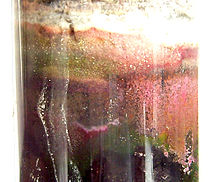
Back Пурпурни бактерии Bulgarian Bacteris porpra Catalan Purpurové bakterie Czech Purpurbakterien German Bacteria púrpura Spanish Purpurbakterid Estonian Bakterio gorrindol Basque باکتری بنفش Persian Purppurabakteeri Finnish Bactérie pourpre French

Purple bacteria or purple photosynthetic bacteria are Gram-negative proteobacteria that are phototrophic, capable of producing their own food via photosynthesis.[1] They are pigmented with bacteriochlorophyll a or b, together with various carotenoids, which give them colours ranging between purple, red, brown, and orange. They may be divided into two groups – purple sulfur bacteria (Chromatiales, in part) and purple non-sulfur bacteria. Purple bacteria are anoxygenic phototrophs widely spread in nature, but especially in aquatic environments, where there are anoxic conditions that favor the synthesis of their pigments.[2]
- ^ Bryant DA, Frigaard NU (November 2006). "Prokaryotic photosynthesis and phototrophy illuminated". Trends in Microbiology. 14 (11): 488–496. doi:10.1016/j.tim.2006.09.001. PMID 16997562.
- ^ Cohen-Bazire G, Sistrom WR, Stanier RY (February 1957). "Kinetic studies of pigment synthesis by non-sulfur purple bacteria". Journal of Cellular and Comparative Physiology. 49 (1): 25–68. doi:10.1002/jcp.1030490104. PMID 13416343.
© MMXXIII Rich X Search. We shall prevail. All rights reserved. Rich X Search